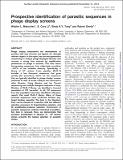| dc.contributor.author | Li, Shuo C. | |
| dc.contributor.author | Matochko, Wadim L. | |
| dc.contributor.author | Tang, Sindy K. Y. | |
| dc.contributor.author | Derda, Ratmir | |
| dc.date.accessioned | 2013-12-23T20:01:02Z | |
| dc.date.available | 2013-12-23T20:01:02Z | |
| dc.date.issued | 2013-11 | |
| dc.date.submitted | 2013-10 | |
| dc.identifier.issn | 0305-1048 | |
| dc.identifier.issn | 1362-4962 | |
| dc.identifier.uri | http://hdl.handle.net/1721.1/83247 | |
| dc.description.abstract | Phage display empowered the development of proteins with new function and ligands for clinically relevant targets. In this report, we use next-generation sequencing to analyze phage-displayed libraries and uncover a strong bias induced by amplification preferences of phage in bacteria. This bias favors fast-growing sequences that collectively constitute <0.01% of the available diversity. Specifically, a library of 10[superscript 9] random 7-mer peptides (Ph.D.-7) includes a few thousand sequences that grow quickly (the ‘parasites’), which are the sequences that are typically identified in phage display screens published to date. A similar collapse was observed in other libraries. Using Illumina and Ion Torrent sequencing and multiple biological replicates of amplification of Ph.D.-7 library, we identified a focused population of 770 ‘parasites’. In all, 197 sequences from this population have been identified in literature reports that used Ph.D.-7 library. Many of these enriched sequences have confirmed function (e.g. target binding capacity). The bias in the literature, thus, can be viewed as a selection with two different selection pressures: (i) target-binding selection, and (ii) amplification-induced selection. Enrichment of parasitic sequences could be minimized if amplification bias is removed. Here, we demonstrate that emulsion amplification in libraries of ~10[superscript 6] diverse clones prevents the biased selection of parasitic clones. | en_US |
| dc.language.iso | en_US | |
| dc.publisher | Oxford University Press | en_US |
| dc.relation.isversionof | http://dx.doi.org/10.1093/nar/gkt1104 | en_US |
| dc.rights.uri | http://creativecommons.org/licenses/by/3.0/ | en_US |
| dc.source | Oxford University Press | en_US |
| dc.title | Prospective identification of parasitic sequences in phage display screens | en_US |
| dc.type | Article | en_US |
| dc.identifier.citation | Matochko, W. L., S. Cory Li, S. K. Y. Tang, and R. Derda. “Prospective identification of parasitic sequences in phage display screens.” Nucleic Acids Research (November 11, 2013). | en_US |
| dc.contributor.department | Massachusetts Institute of Technology. Department of Biological Engineering | en_US |
| dc.contributor.mitauthor | Li, Shuo C. | en_US |
| dc.relation.journal | Nucleic Acids Research | en_US |
| dc.eprint.version | Final published version | en_US |
| dc.type.uri | http://purl.org/eprint/type/JournalArticle | en_US |
| eprint.status | http://purl.org/eprint/status/PeerReviewed | en_US |
| dspace.orderedauthors | Matochko, W. L.; Cory Li, S.; Tang, S. K. Y.; Derda, R. | en_US |
| mit.license | PUBLISHER_CC | en_US |
| mit.metadata.status | Complete | |
